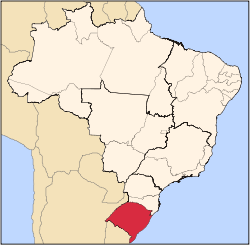Pinhal Grande | |
|---|---|
 Location in Rio Grande do Sul state | |
| Coordinates: 29°20′46″S53°18′24″W / 29.34611°S 53.30667°W | |
| Country | Brazil |
| Region | South |
| State | Rio Grande do Sul |
| Mesoregion | Centro Ocidental Rio-Grandense |
| Microregion | Santiago |
| Area | |
• Total | 477.13 km2 (184.22 sq mi) |
| Elevation | 394 m (1,293 ft) |
| Population (2022 [1] ) | |
• Total | 3,805 |
| • Density | 7.975/km2 (20.65/sq mi) |
| Time zone | UTC−3 (BRT) |
| Postal code | 98150-xxx |
| Area code | +55 51 |
| Website | www |
Pinhal Grande (Portuguese meaning "large pine forest") is a municipality of the central part of the state of Rio Grande do Sul, Brazil.




